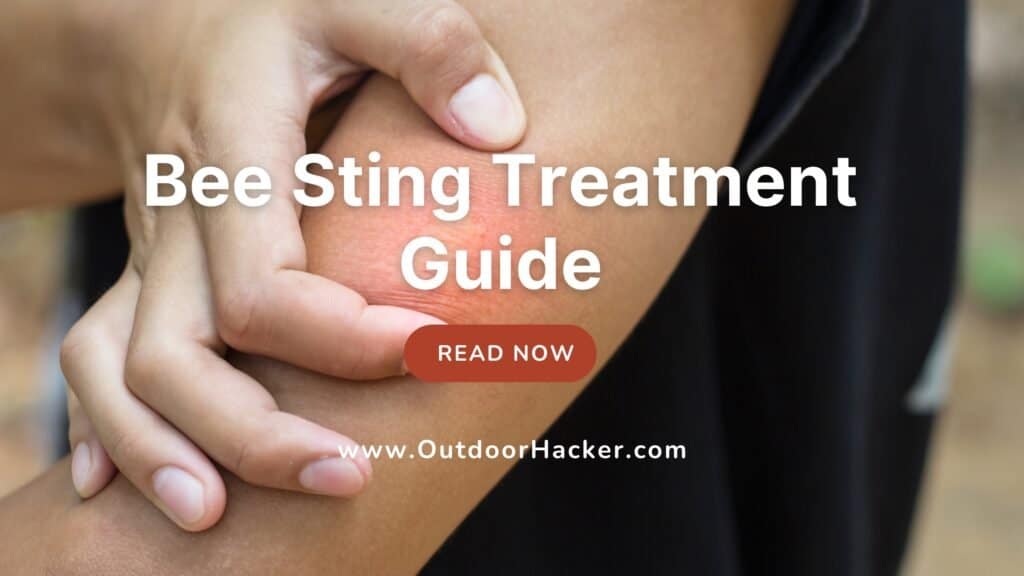Ever been on the sharp end of a bee’s life work? Sure, it’s not the buzz you were looking for. Understanding how your skin throws a fit after a sting can be as complex as the bee’s dance itself. But don’t worry, your journey to soothing that sting starts now.
Before you morph into a human pincushion, let’s decode the red badges of courage blooming across your skin. Getting stung might be a rite of passage during picnics, but knowing what’s normal versus an urgent buzz for help is crucial.
Symptoms range from “ouch” to “oh no!”
Ready for some sting operation intel? Let’s dive into a hive of remedies, from ice cubes to essential oils that’ll have you saying, “Honey, I’m home!” quicker than you can swat a swarm.
There are more than 20,000 different species of bees in the world today.
This Bee Sting Treatment guide promises to be the sweet spot between traditional first aid and the wondrous world of home remedies, ensuring you’re prepared for every sting the great outdoors throws your way.
Table Of Contents
Common Bee Sting Symptoms
So, you’ve joined the not-so-exclusive club of people stung by a bee. Ouch, right? Bee stings are definitely not the most pleasant of experiences, but they are a common one, particularly in the United States where bees are practically members of the outdoor welcoming committee. When these zippy little stinging insects decide to leave their mark, they can cause a range of symptoms that most folks brush off.
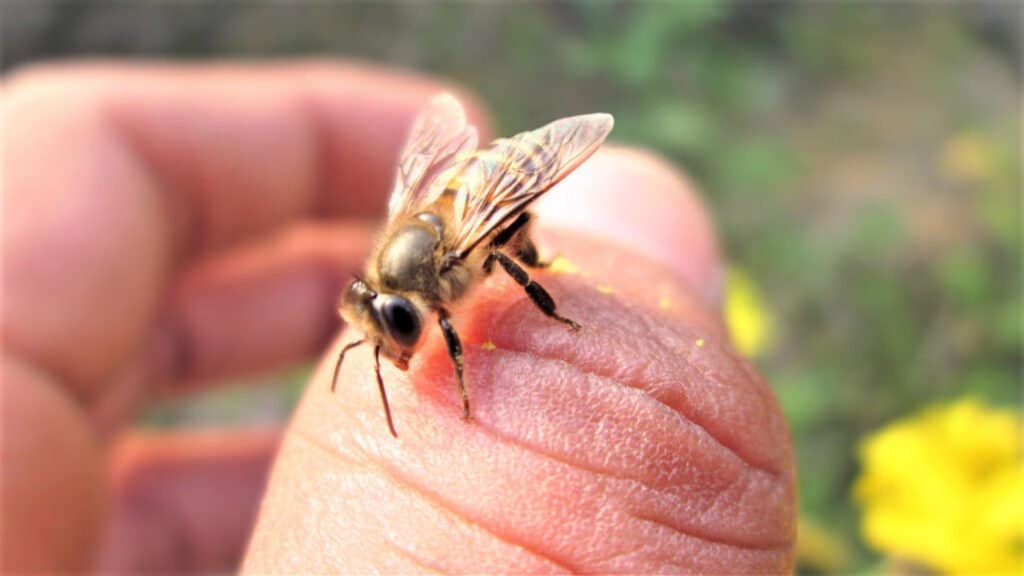
But it’s still worth knowing what to look out for—because if you’re dealing with a bee sting allergy reaction or, say, a bee sting for dogs (yep, our furry friends get zapped too), you’ll want to be prepared.
Most reactions to bee stings are pretty mild, causing nothing more than a bit of pain and irritation. However, it’s not all sunflowers and honey—some reactions can be severe, signaling a trip to the emergency medical folks might be in order.
Whether you’ve faced the wrath of honeybees, yellow jackets, or other winged warriors of the insect world, let’s dive into what can happen when their stingers introduce themselves to your skin.
1. Severe Pain and swelling:
Dealing with the discomfort of pain and swelling can be quite bothersome, whether it’s the result of an injury, infection, or other causes. The sensation of pain is your body’s way of signaling trouble, prompting you to take action.
Swelling, or inflammation, is a natural part of the body’s healing process, although it can be painful and uncomfortable.
When addressing pain and swelling, it’s crucial to:
- Keep the swollen area elevated to reduce blood flow and consequently, the swelling.
- Apply a cold compress to the affected area for short periods to numb the pain and decrease swelling.
- Use over-the-counter anti-inflammatory medications, such as ibuprofen or aspirin, to alleviate pain and reduce inflammation.
- Stay hydrated and maintain a healthy diet to support the body’s healing process.
In cases where pain and swelling persist or are severe, seeking medical attention is advised to rule out serious conditions and to get appropriate medical care.
Remember, these are general guidelines; always consider individual situations and consult with a healthcare provider for personalized advice.
2. Itching and redness:
Itching and redness are common responses to a variety of irritants, including insect stings, skin contact with allergens, and even certain medical conditions. When an irritant comes into contact with the skin, it can trigger an immune system response.
The body releases histamines, which increase blood flow and white blood cell count around the affected area, leading to the inflammation and itching that are all too familiar.
For example, bee stings are notorious for causing itching and redness. The bee venom injected into the skin causes a localized reaction. In cases where someone doesn’t have a bee sting allergy reaction, the symptoms are usually manageable with home remedies. However, some stinging insects like yellow jackets can trigger a severe reaction in sensitive individuals, necessitating medical attention.
Remember to keep a close eye on symptoms following any exposure to potential irritants. If over-the-counter solutions don’t help, or if the reaction worsens, it’s time to get medical treatment promptly.
| Symptom | Typical Causes | Over-the-Counter Treatment | Emergency Signs |
|---|---|---|---|
| Itching | Insect stings, allergens | Hydrocortisone cream, antihistamines | Spread of redness, severe discomfort |
| Redness | Skin irritation, inflammation | Hydrocortisone cream | Difficulty breathing, facial swelling |
3. Allergic reactions:
Alright, real talk—a small percentage of people can have a severe reaction to insect stings, known as an allergic or even an anaphylactic reaction. This is when your body goes into overdrive against the bee venom and can lead to more intense symptoms like increased heart rate, loss of consciousness, or a noticeable drop in blood pressure. If you’re in this camp, you know a bee sting cure isn’t as simple as slapping on some cream and calling it a day.
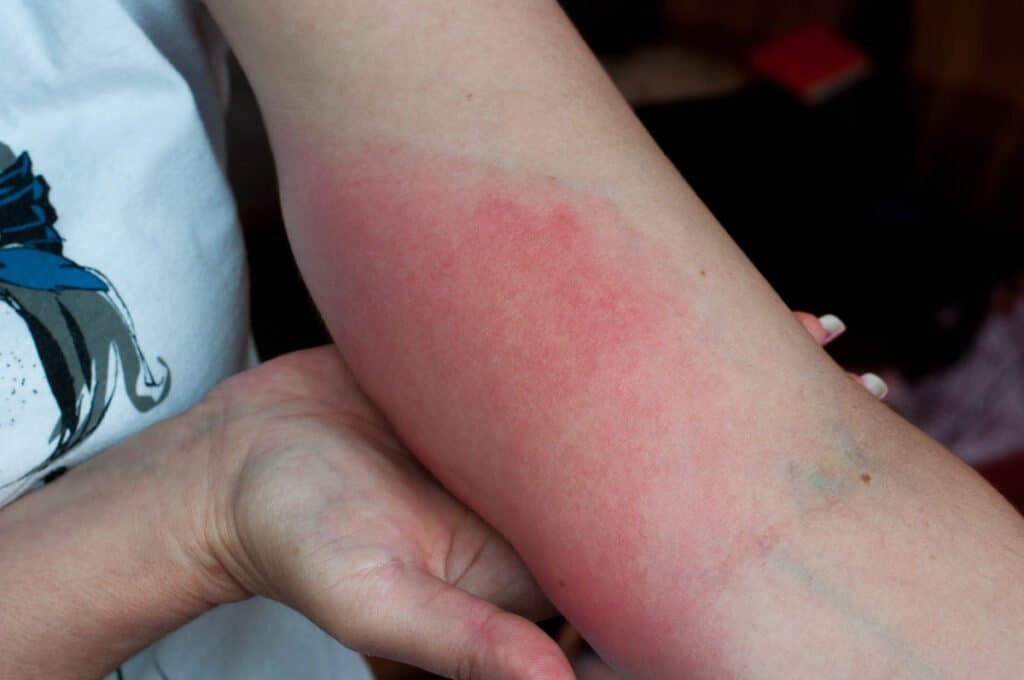
Watch out for symptoms of medical emergency like difficulty breathing, swelling of the face or mouth, or a sense of doom (and not just because you got stung). If you’re seeing signs of a severe reaction, forget reading lists online—get medical attention pronto.
Remember, bee stings can be pesky and occasionally downright dangerous. Keep insect repellents handy, avoid bright colors that make bees think you’re a flower buffet, and always have a plan for medical care if you’re allergic to these little buzzers. Whether you’re managing bee sting inflammation, looking for a bee sting cure, or dealing with stings from other buzzy critters, it pays to know your stuff.
Bee Sting Self- Diagnosis and Seeking Medical Help
When you get stung by a bee, your body’s reaction can usually give you all the clues you need for a diagnosis. If you’ve been stung, your main symptoms will often include a red welt with a small, white spot where the sting happened. This spot is where the stinger entered your skin.
Remember that most folks will only experience local symptoms right around the sting site, which are uncomfortable but not dangerous.
Self-diagnosis:
First up, don’t panic. Most bee stings can be managed at home. Here’s a quick self-diagnosis checklist for a typical bee sting:
- Look for a red welt.
- Check for a white spot where the stinger might have been.
- See if the area around the sting is swollen and warm.
- Assess the pain level; bee stings can hurt quite a bit.
- Take note of any itching.
If your symptoms align with these, chances are good you’ve got a common bee sting on your hands (or wherever you’ve been stung). A little tender loving care with some ice and maybe an antihistamine should do the trick.
Seeking medical expert help:
Okay, so when do you need to make a move to see a doctor?
Here’s a rundown of red flags that signal it’s time to seek medical attention:
- You’ve been stung multiple times, and the cumulative effect of the venom is making you feel ill.
- The sting is in your mouth or throat area—this could swell up and affect your breathing.
- You’re experiencing symptoms of an allergic reaction, like hives, swelling around your face and mouth, difficulty catching your breath, or dizziness.
- The local reaction seems super severe. Like, “Hey, my whole arm is blowing up!” level of severe.
- Symptoms worsen or persist beyond a few days.
If any of these apply, pop over to your doc, urgent care, or emergency department to make sure everything gets checked out and managed properly. Stinging insects are no joke if you’re having an unusual or severe reaction.
Quick Fix For Bee Sting
Oh man, so you just got nailed by a bee, huh? That sting can really throw a wrench into your day. But don’t worry, there are some pretty straightforward steps you can take to manage those ouchie symptoms. Let’s chat about what to do to reduce the sting, the swell, and the itch, keeping you from going full-on Hitch (you know, like Will Smith in that movie where his face swells up like a balloon).
1. Applying ice or a cold compress
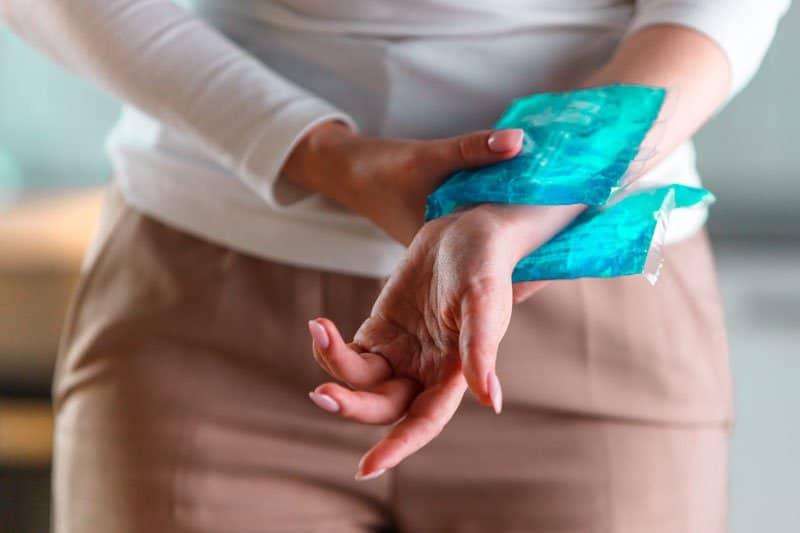
Applying ice or a cold compress can be an essential step in treating a bee sting and other insect stings. This method is particularly effective at reducing swelling, pain, and inflammation caused by the sting.
Here’s a quick rundown of how to do it effectively:
Step-by-Step Use of Ice/Cold Compress for Bee Stings:
- Safety First: Ensure the stinger is removed if it’s a bee sting. Honey bee stingers are barbed and get left behind, but this isn’t the case for wasps and yellow jackets.
- Clean the Area: Wash the affected area with soap and water to prevent infection.
- Cold Application: Wrap ice or a cold pack in a cloth—never apply ice directly to the skin as it can cause frostbite.
- Timing: Apply the cold compress to the area for about 20 minutes.
- Frequency: Repeat the application every few hours as needed.
- Avoid Heat: Don’t use hot compresses or baths, as they can increase circulation and worsen swelling.
- Seek Medical Care: If symptoms of an allergic reaction occur, such as difficulty breathing, swelling of the lips or throat, or a severe reaction, get emergency medical help immediately.
Note: While ice or a cold compress provides symptomatic relief, it’s not a cure for bee sting allergies or a replacement for medical treatment in the case of severe reactions.
2. Taking antihistamines
Taking antihistamines can be an effective way to manage the symptoms associated with bee sting allergies. When a bee sting occurs, the body releases histamine, a compound that contributes to inflammation and other allergic reaction signs.
Antihistamines work by blocking the action of histamine, thus reducing symptoms like swelling, redness, and itching.
Here is a simple list to consider when taking antihistamines for a bee sting:
- Type: Choose oral antihistamines for a systemic reaction.
- Dosage: Follow the instructions on the label or as prescribed by a healthcare professional.
- Timing: Take as soon as possible after the sting for best results.
- Frequency: Generally taken once every 4-6 hours, but check the specific drug guidelines.
- Duration: Continue as long as the symptoms persist, up to the maximum daily dose.
- Precaution: Avoid alcohol and operating heavy machinery due to possible drowsiness.
It’s essential to note that while antihistamines can help manage mild reactions to stings, they may not be sufficient for severe allergic responses.
Always seek emergency medical care if experiencing a severe reaction, including loss of consciousness, difficulty breathing, or a life-threatening anaphylactic reaction. Antihistamines should not replace emergency medical treatment but can be a component of the medical care for bee sting reactions.
3. Using essential oils
Essential oils are concentrated extracts from plants and boast a variety of uses from aromatherapy to skin care. Using these oils typically involves diluting a few drops in a carrier oil before applying topically or using a diffuser to spread the aroma throughout a space. It’s important to conduct a patch test to check for any allergic reactions before applying broadly on the skin.
| Method | Use |
|---|---|
| Inhalation | Aromatherapy, respiratory relief |
| Topical | Applied to skin after dilution with a carrier oil for localized effects |
List for safe usage:
- Always dilute essential oils with a carrier oil such as jojoba or coconut oil before skin application.
- Perform a patch test to ensure no allergic reaction.
- Consult a professional before using essential oils if pregnant, nursing, or under medical treatment.
- Keep away from eyes, inner ears, and sensitive areas.
- Use a diffuser for inhalation rather than applying directly to your skin or ingesting.
Remember, essential oils are potent and should be used with caution and respect for their concentrated nature.
3 Best Home Remedies for Bee Stings:
Before we dive into a few trusty home remedies, it’s important to know that if you’re having a bee sting allergy reaction, you should seek medical treatment pronto. And of course, let’s keep our furry friends in mind; bee sting for dogs can be a different story, so consult your vet if your pooch gets stung.
Now, for those bee sting inflammations that are not so severe, and you’re looking for a way to ease the pain and swelling at home, here are a few handy tricks to try.
1. Baking soda paste
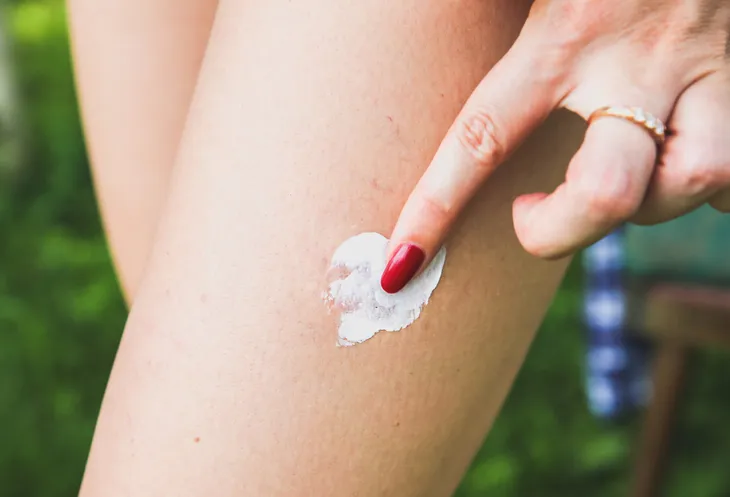
Baking soda, known chemically as sodium bicarbonate, is a versatile household product with a wide array of uses, including bee sting treatment. Here’s a descriptive guide on how to use baking soda paste for bee stings:
Ingredients:
- Baking soda
- Water
Steps:
- Mix baking soda and water in a 3:1 ratio to create a thick paste.
- Apply the paste generously over the sting area.
- Leave the paste on the skin for at least 15 minutes before washing it off.
Effectiveness:
- Baking soda is believed to neutralize bee venom, alleviating pain and reducing inflammation.
Tips for Best Results:
- Use the paste immediately after the sting to prevent severe reactions.
- Do not rub the affected area, as this can cause further irritation.
Considerations:
- Seek medical attention if you have an allergic reaction, such as difficulty breathing, swelling of the face or mouth, or a severe rash.
- For those with bee sting allergies, always have an emergency plan in place.
Note: While many swear by this home remedy, scientific evidence supporting its effectiveness is limited. Always consult with a healthcare provider for severe or questionable reactions.
2. Honey
Honey, a natural sweetener made by bees using the nectar from flowers, is a staple in many kitchens around the world. Not only is it used in various recipes for its rich flavor, but it’s also known for its potential health benefits.
Apply a small amount to the affected area. Cover with a loose bandage and leave on for up to an hour, it can reduce your bee sting pain and protect from spreading the venom.
Honey contains antioxidants, which can combat oxidative stress and inflammation. It also has antibacterial and antifungal properties, thanks to an enzyme that produces hydrogen peroxide.
Nutritionally, honey offers trace amounts of vitamins and minerals, including vitamin C, calcium, and iron. It also provides a healthier glycemic index (GI) compared to regular sugar, meaning it doesn’t spike blood sugar levels as quickly. However, it is high in calories and should be consumed in moderation.
One should note, honey is not recommended for infants under a year old due to the risk of botulism. When purchasing honey, opting for raw or pure honey can provide more health benefits than the processed varieties, which may contain added sugars or syrups.
Here’s a quick info table:
| Component | Detail |
|---|---|
| Type | Natural sweetener |
| Source | Bees from flower nectar |
| Health Benefits | Antioxidants, Antibacterial, Antifungal |
| Nutritional Value | Vitamins, Minerals, Lower GI than sugar |
| Caloric Content | High in calories |
| Consumption Tips | Use in moderation; not for infants under 1 year |
Remember, while honey is seen as a healthier alternative to sugar, its consumption should still be balanced within a diet.
3. Vinegar
Vinegar is a versatile liquid that consists of acetic acid, water, and other trace chemicals. It’s primarily produced through the fermentation of ethanol by acetic acid bacteria. Due to its acidic nature, vinegar is widely used in the culinary world as a condiment, for pickling, and as a flavor enhancer.
Types of Vinegar:
- Distilled White Vinegar: Ideal for cleaning and marinades.
- Apple Cider Vinegar: Used for health remedies and salad dressings.
- Balsamic Vinegar: Known for its rich flavor and use in Italian dishes.
- Wine Vinegar: Derived from red or white wine, perfect for vinaigrettes.
- Rice Vinegar: Common in Asian cuisine, it has a milder taste.
Common Uses:
- Culinary purposes
- Medical remedies
- Cleaning agent
- Weed killer
- Preservative
Health Benefits:
- May aid in weight loss
- Can improve digestion
- Helps control blood sugar levels
Cleaning Efficacy:
- Disinfects surfaces
- Removes odors
- Acts against mold and mildew
Always remember, the concentration of acetic acid in vinegar can vary, and it should be used with caution, especially when concentrated. In cooking, vinegar can balance flavors and add a distinct tartness. It’s truly an essential item in just about any pantry!
BONUS: How To Prevent Bee Stings?

Nobody’s clamoring for a bee sting; those little buggers can hurt! Whether you’re puttering around your backyard or hiking in a lovely flower-filled meadow, it’s smart to know the A-B-C’s of dodging those pesky needle-butt insects.
So, let’s dive into some nifty tips to keep your skin sting-free and your outdoor moments enjoyable.
1. Wearing protective clothing
Wearing protective clothing, especially when spending time outdoors, can dramatically reduce the chance of stings from stinging insects like bees, yellow jackets, and wasps. These insects are often attracted to bright colors and floral patterns, so it’s wise to opt for clothing in muted hues, such as whites and tans. Long sleeves, pants, and closed-toe shoes provide physical barriers that can prevent insects from reaching the skin.
In addition to reducing your risk of insect stings, protective attire might also safeguard you from other outdoor irritants and bites. If you’ll be in an area with a high insect population, consider applying insect repellents to any exposed skin and possibly your clothes, following product guidelines.
Below is a short checklist for protective clothing to minimize the risk of stings:
- Wear light-colored clothing (white, beige, light gray)
- Opt for smooth textures over wool or leather
- Choose long sleeves and pants over shorts and T-shirts
- Use closed-toe shoes instead of sandals
- Apply insect repellent as directed
- Avoid floral patterns that mimic flower attractions
- Consider a hat or netting if in a heavily infested area
Keeping these tips in mind when dressing for outdoor activities can help you avoid uncomfortable and potentially dangerous encounters with stinging insects.
2. Avoiding areas with high bee activity
Staying clear of places buzzing with bees is smart if you’re not a fan of unwanted flying guests. To reduce the odds of encountering stinging insects like honey bees and yellow jackets:
- Dress Wisely: Skip bright colors or flowery prints that draw bees like magnets. Think neutral shades to blend in rather than stand out.
- Watch Your Fragrance: Heavy scents can attract bees, so it’s best to go light on perfumes, aftershaves, and scented lotions.
- Be Cautious With Food: Eating outdoors, especially sweet stuff, is like rolling out the welcome mat for bees. Keep food covered and be vigilant.
- Tread Carefully: Gardens, orchards, and clover fields are bee hotspots. Also, steer clear of trash bins since yellow jackets aren’t picky diners.
- Check Your Space: Before settling down for that picnic, do a quick recce for nests in the ground or overhanging branches.
Cautionary Measures
- Wear closed-toe shoes in grassy areas.
- Use insect repellents, but check for bee-friendliness.
- Avoid drinking from open soda cans outdoors; a curious bee can sneak inside.
By keeping these tips in mind, you can better skirt the zones that bees find irresistible, and enjoy a sting-free day. Remember, if you have a bee sting allergy reaction, always carry an epinephrine auto-injector, just in case.
3. Removing food and drinks from outdoor areas
When munching outdoors, it’s easy to forget that your feast may attract some uninvited guests. That’s right, stinging insects like bees and yellow jackets could be lured by the aroma of your BBQ, and no one wants to deal with a bee sting while enjoying their burger.
So, here are some quick guidelines on how to keep your patio picnic sting-free by removing food and drinks from outdoor areas:
- Clear Immediately: Once the eating is done, promptly remove any leftover food, used plates, and utensils.
- Tightly Seal Trash: Make sure garbage bags are securely fastened and placed in bins with tight-fitting lids to prevent insects from catching a whiff.
- Cover Sweet Drinks: Bees and wasps have a thing for sugary sodas and juices. Keep these covered or capped when not in use.
- Rinse Recyclables: Those soda cans and jelly jars can be traps for curious insects. Give them a quick rinse before dropping them in the recycle bin.
- Leftover Watch: Constantly scan the area for forgotten pieces of food or spilled drinks and clean them up ASAP.
By following these simple steps, you can help prevent stinging insects from crashing your outdoor dining experience and keep bee stings, and the need for bee sting treatment, at bay.

